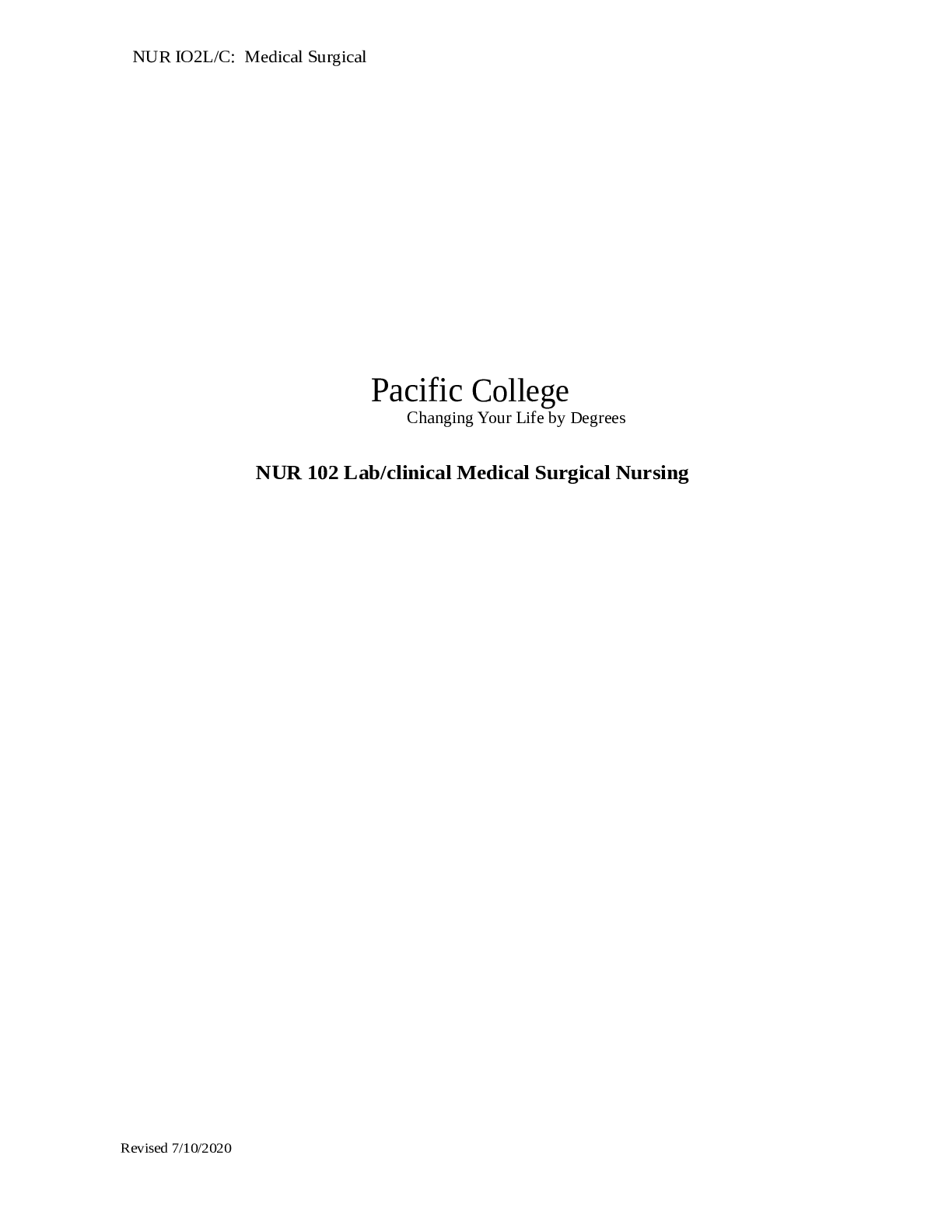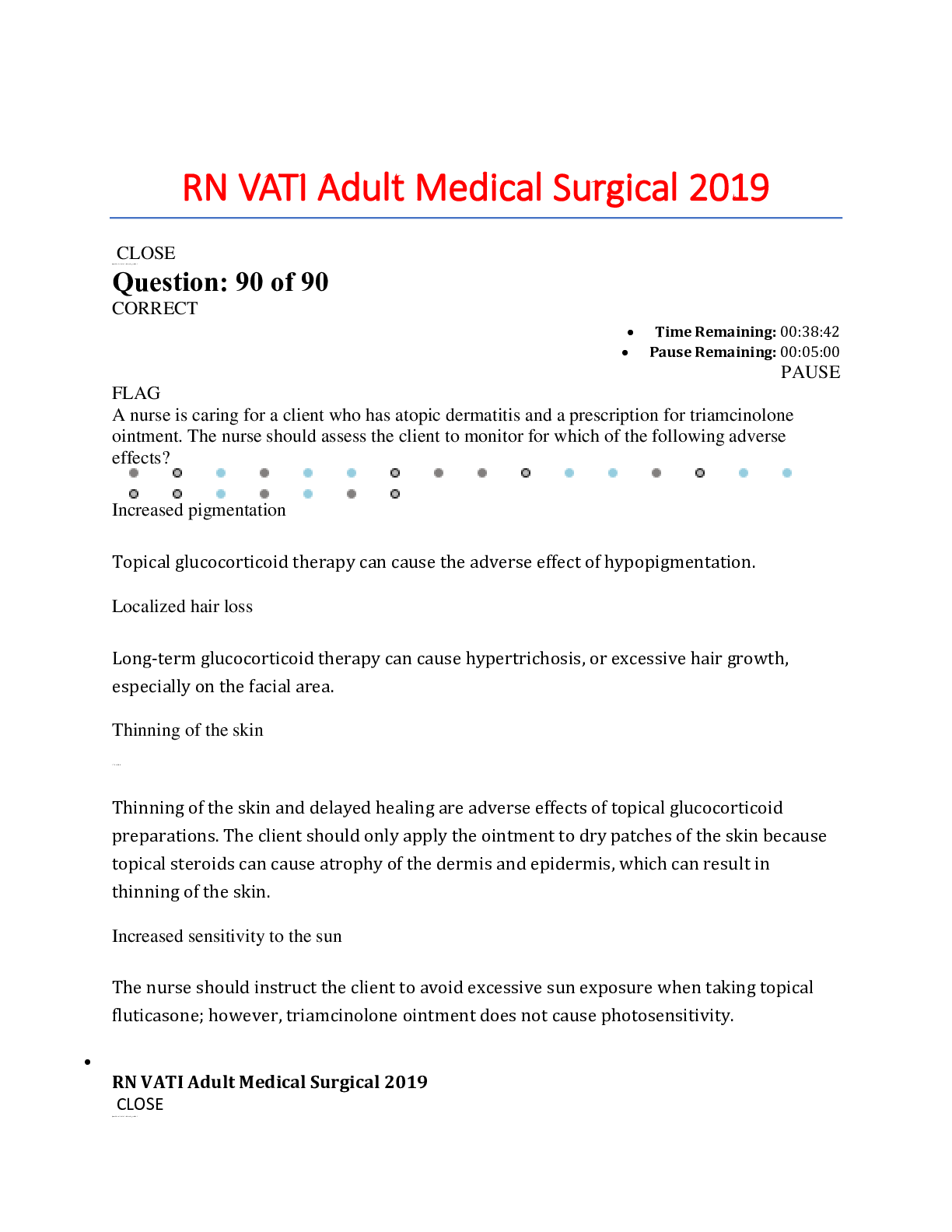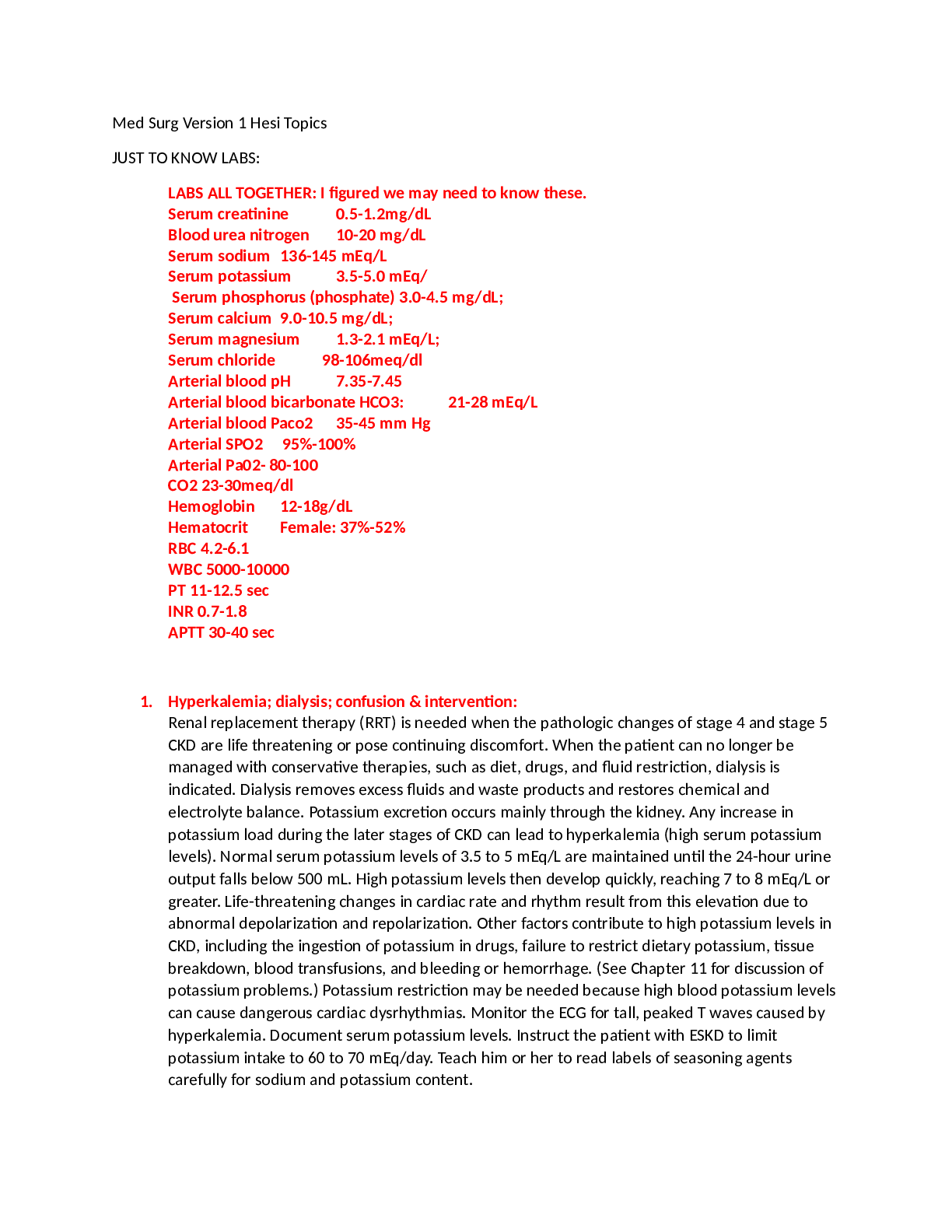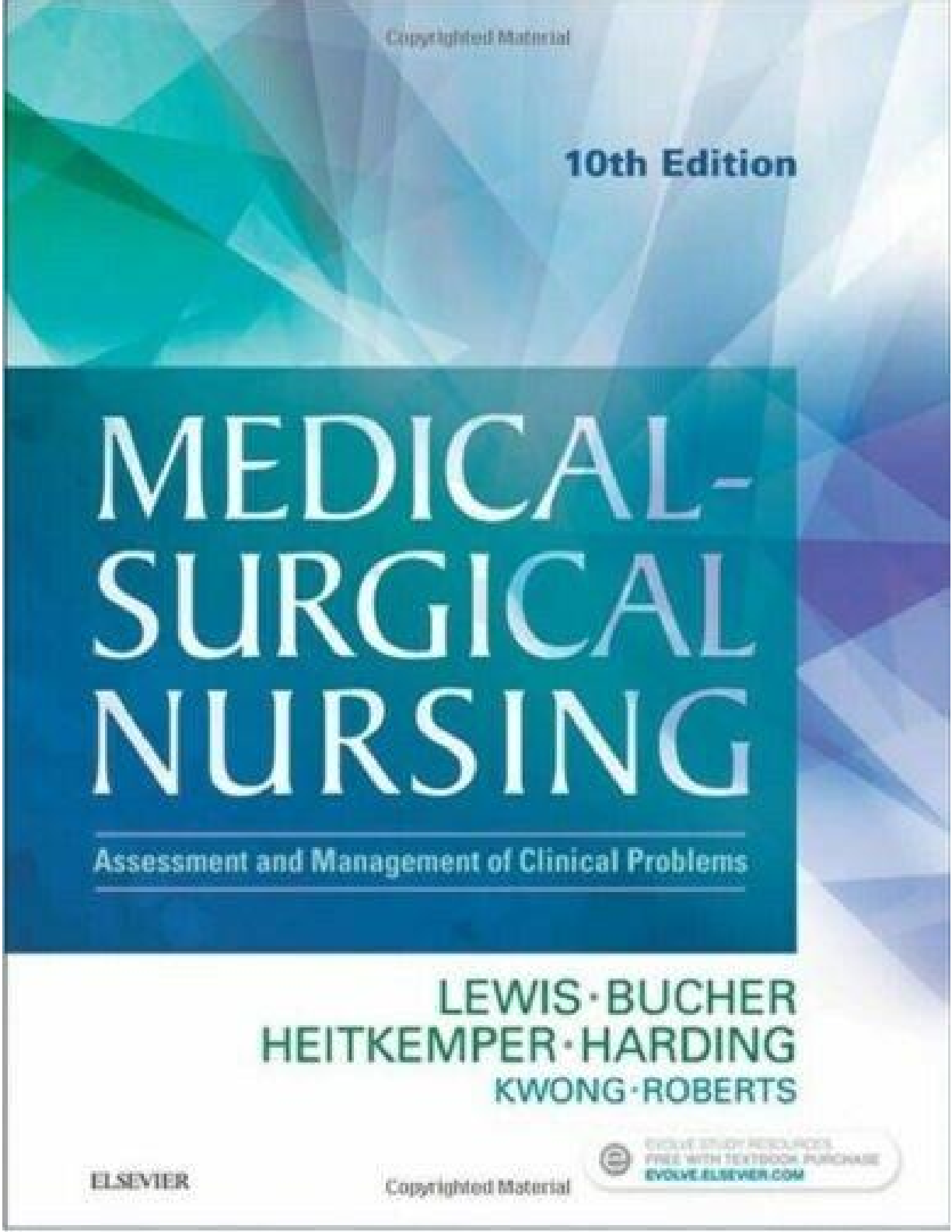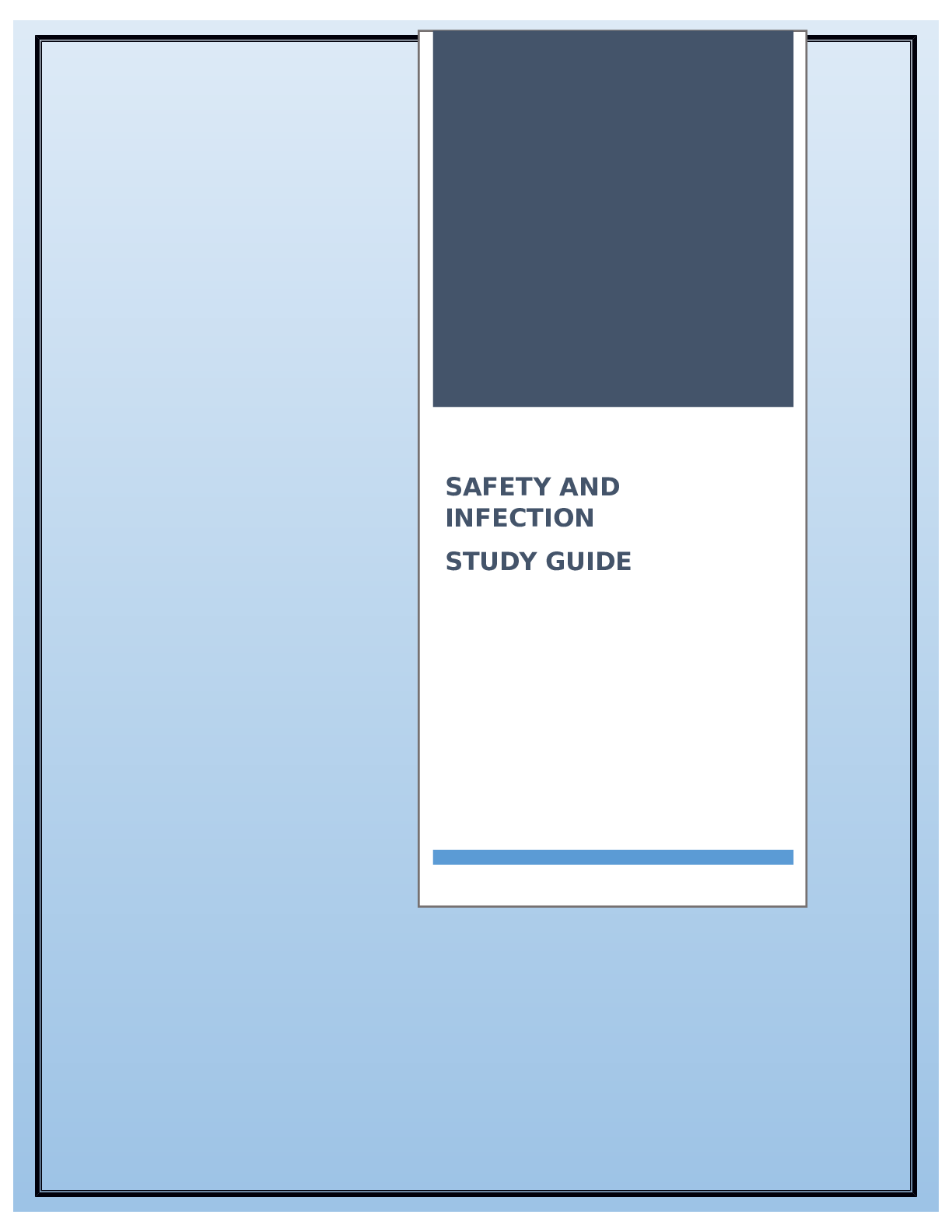*NURSING > STUDY GUIDE > Our Lady of the Lake College - NURS 140 Mental Health; NURSING 140 FINAL STUDY GUIDE (Complete A+ gu (All)
Our Lady of the Lake College - NURS 140 Mental Health; NURSING 140 FINAL STUDY GUIDE (Complete A+ guide) much helpful.
Document Content and Description Below
I. ELDERLY ABUSE • Elderly Abuse- any type of mistreatment or abuse towards an older adult • Usually the abuser is the caregiver, usually the child Risk factors for Elderly Abuse:: • Ol... der than 75 years older, the more feeble, senile, and dependent on others • Female less likely to fight back • Chronic health problems that create dependency on caregiver • Impaired cognitive function less likely to understand, or tell on the abuser • Financial dependency puts stress on the caregiver • A history of violence against the caregiver If you abused them as a child, when you get old they are more likely to beat your ass! Reasons people Abuse:: • Abuser usually has psychological problems (depression, substance abuse) • Stress associated with caring for an elderly person • Feeling overwhelmed with the caregiver role • Learned behavior that is passed down from generation to generation • People are living longer, therefore, older adults may have longer periods of dependency needs • Caregiver may have a history of psychological illness or substance abuse Elder Abuse • Granny Dumping- involves abandoning elderly individuals at emergency departments, nursing homes, or other facilities---literally leaving them in the hands of others when the strain of care giving becomes intolerable. Examples of Elder Abuse • Physical Abuse (striking, hitting, beating, shoving, bruising, cutting, restraining) o S&S:: Frequent, unexplained injuries, or jumping from hospital to hospital, reluctant to seek treatment for injuries, denial, disorientation or grogginessover DRUGGED! Fear or edginess in the presence of family member or caregiver • Psychological Abuse (yelling, insulting, name calling, harsh commands, threats, ignoring, silence, social isolation, withholding affection) o S&S:: Helplessness, Hesitance to talk openly, Anger/agitation, Withdrawal/depression • Neglect (intentional or unintentional): (withholding food or water, inadequate heating, unclean clothes and bedding, lack of needed medication, lack of eyeglasses, hearing aids, false teeth o S&S:: Dirty, smelly, or hazardous living environment, rashes, sores, or lice on the elder, untreated medical condition, malnourished/dehydrated, inadequate clothing • Financial Abuse (OBVIOUS) Irrelevant material… BLAH! BLAH! • Sexual Abuse (Sexual molestation; rape) Any type of sexual intimacy against the elderly person’s will EWWW! • Self-Neglect old people not taking care of themselves.. o Financially, ADL’s, etc… Living in a house with a million cats, roaches… etc. • Warning Indicators From Caregiver o Elder is not given opportunity to speak for self, to have visitors, or to see anyone without the presence of the caregiver, Attitudes of indifference or anger toward the elder, Blaming the elder for his or her illness or limitations, Defensive, Conflicting story b/w elder and caregiver, history of abuse or problems with alcohol or drugs. Nursing Assessment GET TO THE POINT!! ASK THEM STRAIGHT UP:: • Are you afraid of anyone at home? Have you been struck, slapped, or kicked? • Have you been tied down or locked in a room? Are you safe at home? • Assess patient for agitation, depression and fear of the caregiver • Observe caregivers behavior that may signal abuse including humiliating comments, frequent interruptions, use of an unfeeling voice, or lack of caring Lab Studies all of your basic labs + Xray & CT scan for fractures & internal injuries Nursing Diagnosis • Anxiety MAIN DIAGNOSIS, LIVE IN FEAR FROM CARE GIVER!! Nursing Interventions • KEY:::: Early detection, detailed H&P & psychological assessment Nurses’ role • It’s OUR JOB TO RECOGNIZE THE ABUSE—We HAVE TO REPORT IT!!! WE ARE LIABLE!!! GET THEM SAFE & GET THEM HELP!! Report any suspicions to protective social services!! Treatments::: Support Groups, Psych consult, Church Groups, Maid/Housekeeping services helps to take some of the stress off of the caregiver. II. EATING DISORDERS Eating Disorders 1. Anorexia Nervosa 2. Bulimia Nervosa 3. Obesity Possible Causes of Eating Disorders MANY CAUSES.. Biologic Theories:: neurotransmitter disturbances depression, etc. Genetics; there is a genetic link, increased level of vasopressin. Behavioral Theories:: early dieting and approval upon weight loss, when they lose weight- they get concern/attention from loved ones, when they get this attention centered on weight it reinforces the maladaptive behavior Sociocultural Theories:: Social influences, supermodels, VOGUE, “thin is in”, Usually in countries where there is adequate food supply USA Family Based Theories:: Childhood abuse/adversities, high standards of “perfectionism”, Parental criticism, rebellion against the parents, control. Anorexia Nervosa (AN)client refusal/inability to maintain a minimally normal body weight, THEY JUST DON’T EAT HARDLY ANYTHING! significantly disturbed body image, emaciation, and intense fear of b/c obese and denial of their condition. Body weight of 85% or less than expected for their age and height Experience amenorrhea (NO PERIODS) for at least three consecutive cycles Have a preoccupation with food and food related activities Increased incidence of AN in the past 30 years Prevalence rate among young women in the US approximately 0.5-1 percent Predominantly in females aged 12-30 years old, fewer than 10 percent of the cases occur in males AN was once believed to be more prevalent in the higher socioeconomic classes but evidence is lacking to support this Bulimia Nervosa (BN) Is characterized by recurrent (< 2x’s/week for 3 months) uncontrolled consumption of large amounts of food (binge eating) followed by attempts to eliminate the body of excess calories (purging) o Purging- attempts to eliminate the body of excess calories; self induced vomiting, use of laxatives, diuretics, enemas, or emetics, excessive exercising, or fasting Binge eating- uncontrollable consumption of large amounts of food; usually done secretly B/C they are ashamed, followed by strong feelings of guilt/shame, etc.. Usually in a discrete amount of time (w/in 2 hours) **Weight is usually in the normal range Usually begins late adolescence/early adulthood, 18-19 is the typical age at onset. Binge eating frequently begins during or after dieting, in-between episodes they diet, eat salads… etc… sets them up for the next binge/purge… cycle continues.. Are aware that their eating behavior is pathologic and go to great lengths to hide it from others ASHAMED!!! More prevalent than AN easier to do than starve yourself… Cross-cultural research suggests that BN occurs primarily in societies that place emphasis on thinness as the model of attractiveness for women and where an abundance of food is available USA!!! THIN IS IN BABY!!! Medical Complications of Eating Disorders • Musculoskeletal- loss of muscle mass, loss of fat, osteoporosis fractures • Metabolic- Hypothyroidism, hypoglycemia, body’s way of storing fat. • Cardiac- bradycardia, hypotension, loss of cardiac muscle, small heart, cardiac arrhythmias and sudden death MAJOR CARDIAC EFFECTS!! DEADLY!! • GI- Delayed gastric emptying, bloating, constipation, abd. pain, gas, and diarrhea • Neuropsychiatric-Abnormal taste sensation, sleep disturbances • Reproductive-Amenorrhea, low levels of luteinizing & FSH • Dermatologic-Dry, cracking skin due to dehydration • Hematologic- Leukopenia, anemia, thrombocytopenia Relating to purging (laxative and vomiting)—BULEMICS! • Metabolic- Electrolyte abnormalities, ex.-- Hypokalemia, hypomagnesemia, and elevated BUN • GI- Salivary gland and pancreas inflammation and enlargement, esophageal and gastric erosion or rupture, dysfunctional bowel • Dental- Erosion of dental enamel, decay & chipping… etc.. • Neuropsychiatric-Seizures (R/T large fluid shifts and electrolytes disturbances) Nursing Diagnosis for AN and BN 1. Imbalanced nutrition: Less than body requirements related to refusal to eat (#1 diagnosis) 2. Fluid volume deficit (risk for or actual) r/t decreased fluid intake; self induced vomiting, laxative and/or diuretic (Mainly for Bulemics) Nursing Interventions Establish a trusting relationship & convey positive regard. o Develop a contract o First goal is to stop losing weight!! weigh QAM after 1st void… Dietary consult Assess and monitor cardiac functions, electrolytes, strict I&O, Explain to client the privileges and restrictions… restrictions if pt. loses weight Assess skin turgor, integrity. Assess moistness and color of oral mucous membranes DEHYDRATION!! Stay with the client during established time for meals (usually 30 min) and for at least 1 hour following meals MAKING SURE THEY EAT, HOW MUCH & THAT THEY AREN’T PURGING… Let client know if nutrition isn’t maintained, they will be tube fed (don’t threaten, it’s not a punishment, it’s a matter of fact..) Offer liquid protein supplements if the client is unable to complete meal. Encourage client to verbalize feelings… of family/sexuality/etc… Help client recognize ways to gain control over these problematic areas of life. Be alert for attempts to hide or discard food or inflate weight Ask the client to identify feelings & assist client to change stereotypical beliefs Suggest self-monitoring using a journal, relaxation techniques, distraction Obesity an unhealthy accumulation of body fat; defined as having a BMI of >30 Is NOT classified as a psychiatric disorder in the DSM-IV-TR but b/c of the strong emotional factors associated with the condition, it may be considered under “Psychological Factors Affecting Medical Condition.” Is being considered by the American Psychiatric Association as a 3rd type of eating disorder. Obesity is a factor in BED because individual binges on large amounts of food but DOES NOT engage in behaviors to rid the body of the excess calories. (purging) Normal BMI range 20-24.9 More common in black women than white women, & more in white men than black men. Prevalence among lower socioeconomic classes is six times that in upper socioeconomic classes Junk food- easy & cheap, no $ to eat healthy. Possible Causes of Obesity Genetics- 80% of offspring of two obese parents are obese PART GENITIC! Physiological Factors- Lesions in hypothalamus, Hypothyroidism, DMII Lifestyle Factors- an ingestion of greater number of calories than are expended. Many overweight individuals lead sedentary lifestyles, making it very difficult to burn off calories.. (They eat too much, and don’t exercise enough to burn it off.) Treatment Modalities Behavior Modification- System of reward and privileges Individual Therapy- Is not the therapy of choice for eating disorders! Family Therapy- family strongly affected, improve family dynamics Psychopharmacology- No medication specifically indicated for eating disorders!! Drugs have been prescribed for associated symptoms such as anxiety and depression…. o Prozac, Thorazine and Anafranil has been used in clients with anorexia nervosa. Prozac is also used with Bulimia clients& obese clients. Periactin unlabeled use as an appetite stimulant. Other antidepressants: Tofranil, Norpramn, Elavil, and Nardil has been shown to effective. Topramax, an anticonvulsant, has been used in treating BED with obesity. Meridia was approved by the FDA for the treatment of obesity (only for clients who have a significant amount of weight to lose), cardiac side effects is a concern. >>>>>>>>>>>>>>>>>>>>>>>>>CONTINUED>>>>>>>>>>>>>>>>>>>>>> [Show More]
Last updated: 1 year ago
Preview 1 out of 39 pages

Reviews( 0 )
Document information
Connected school, study & course
About the document
Uploaded On
Nov 22, 2020
Number of pages
39
Written in
Additional information
This document has been written for:
Uploaded
Nov 22, 2020
Downloads
0
Views
48



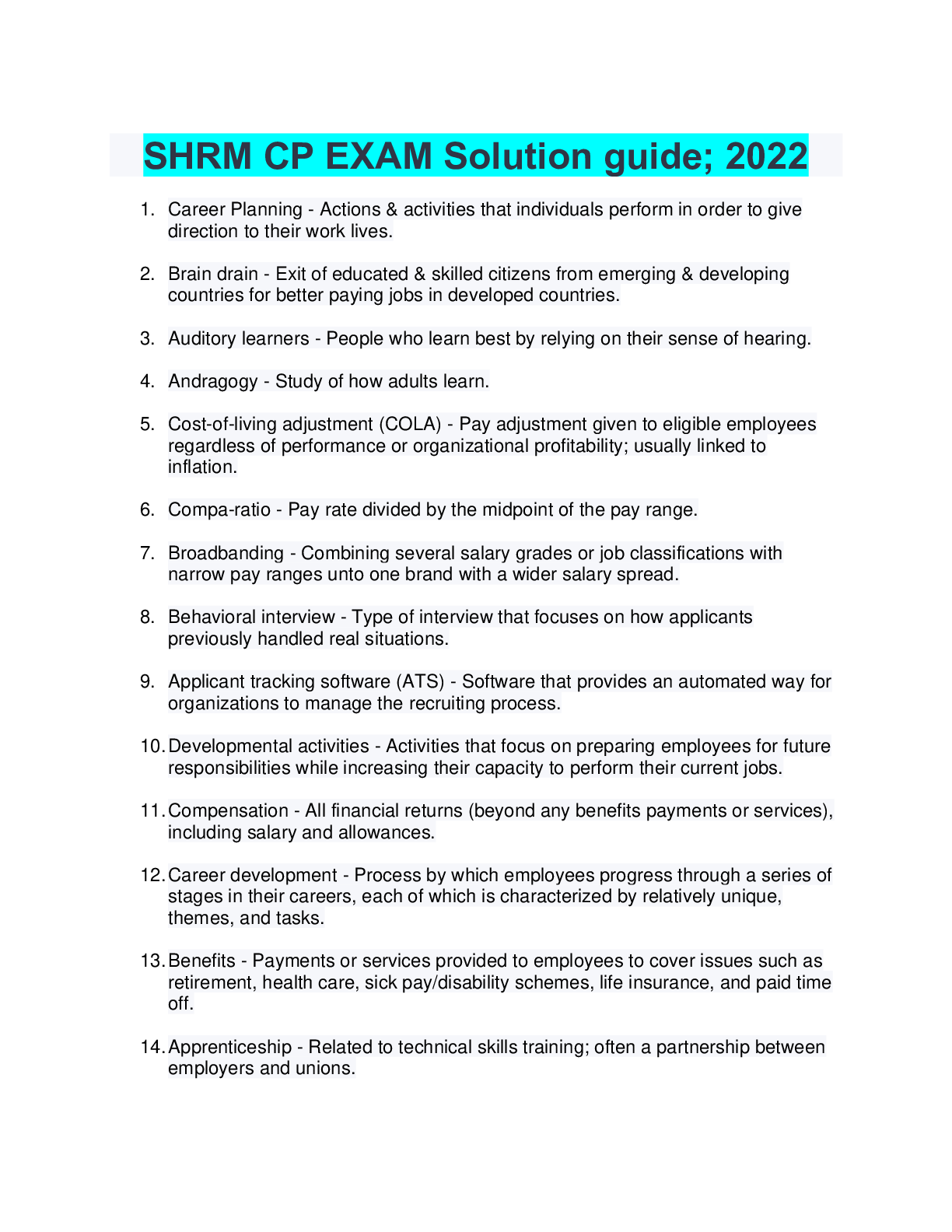
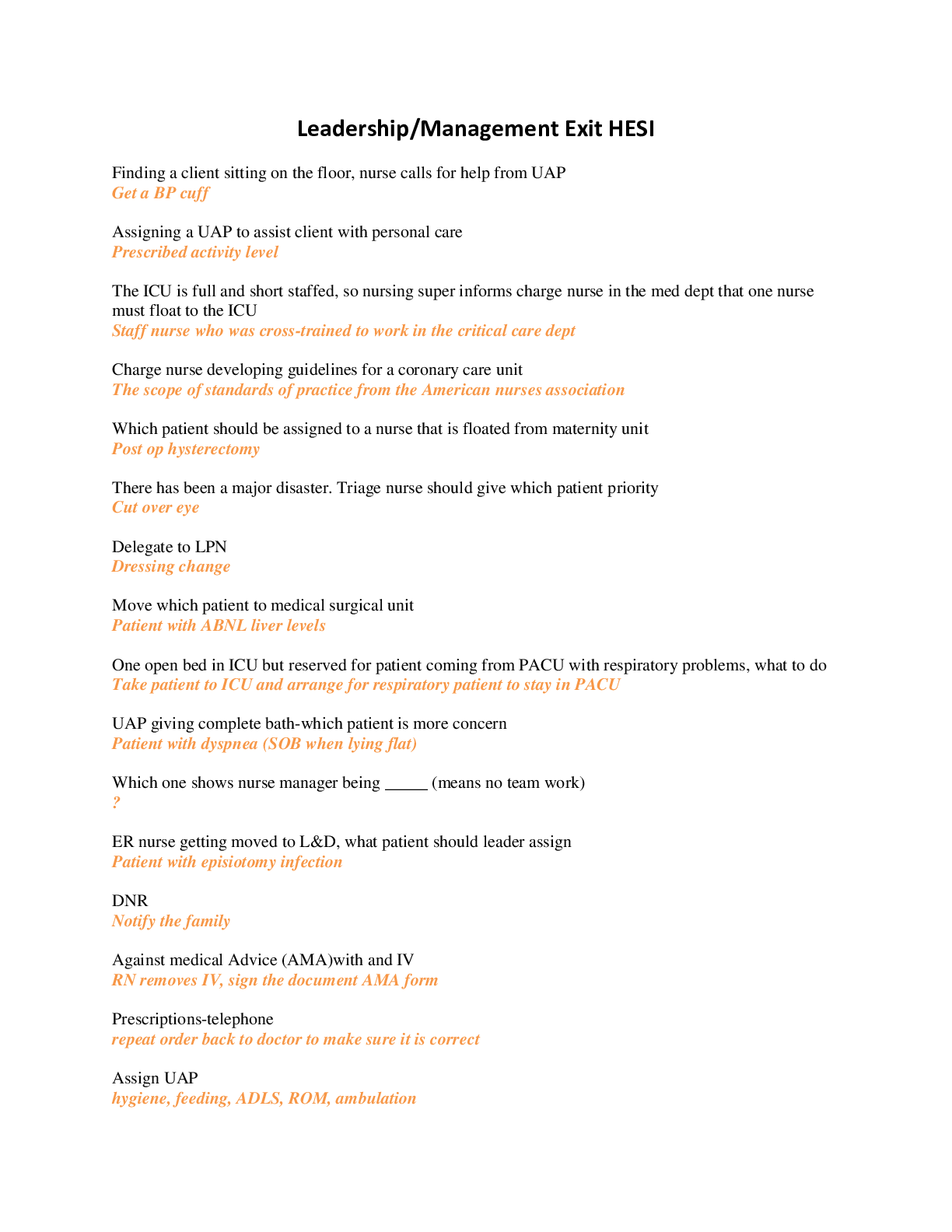
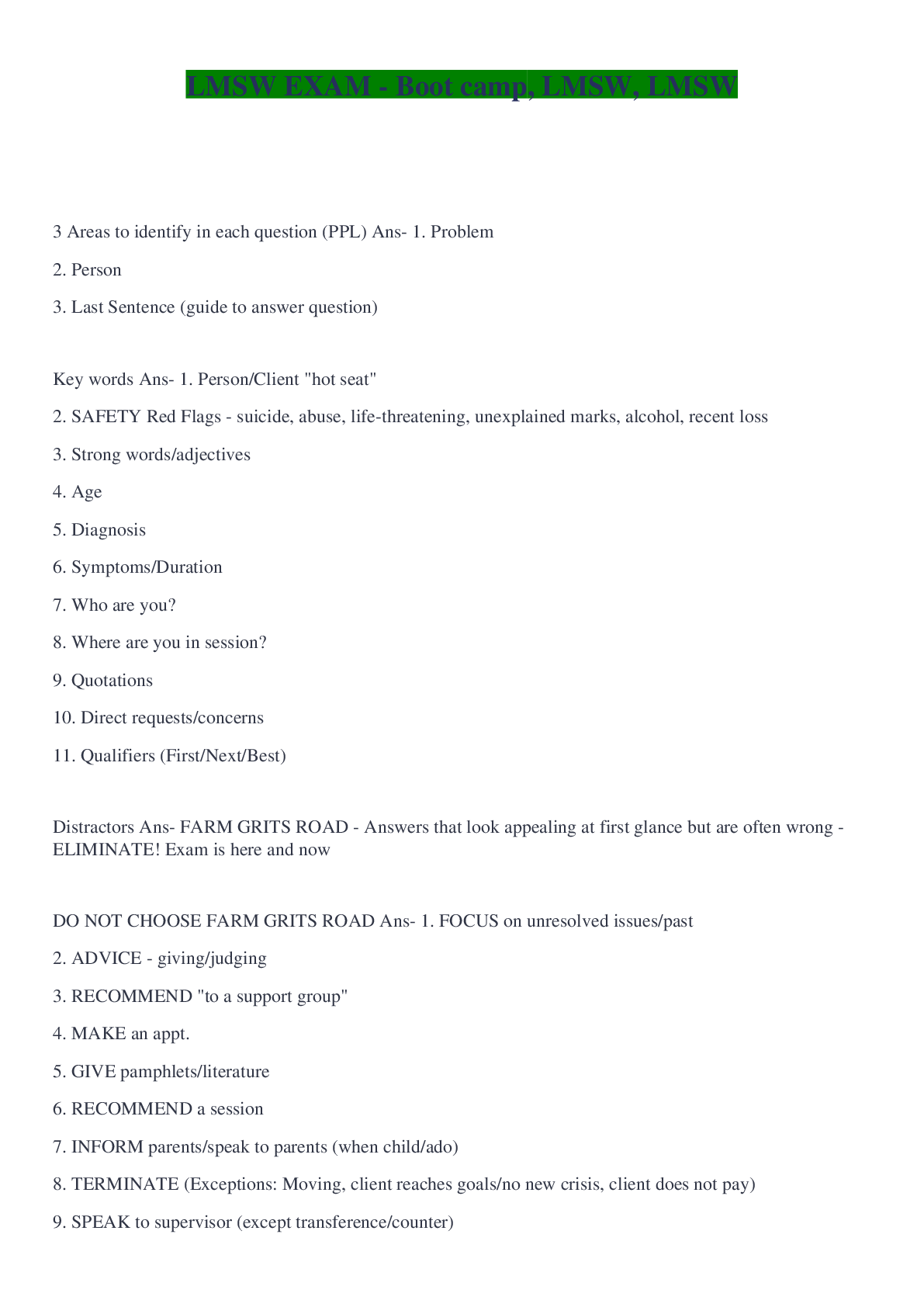

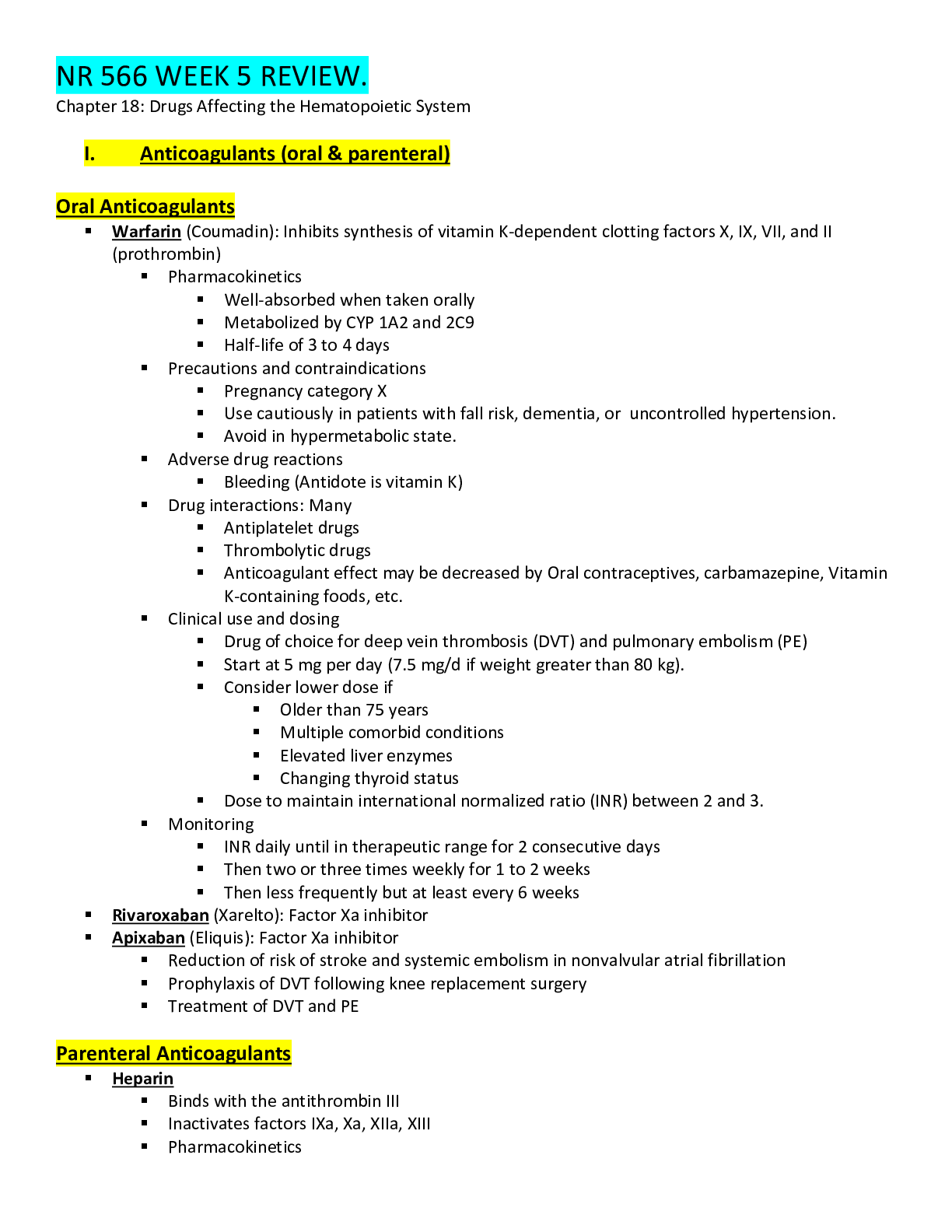


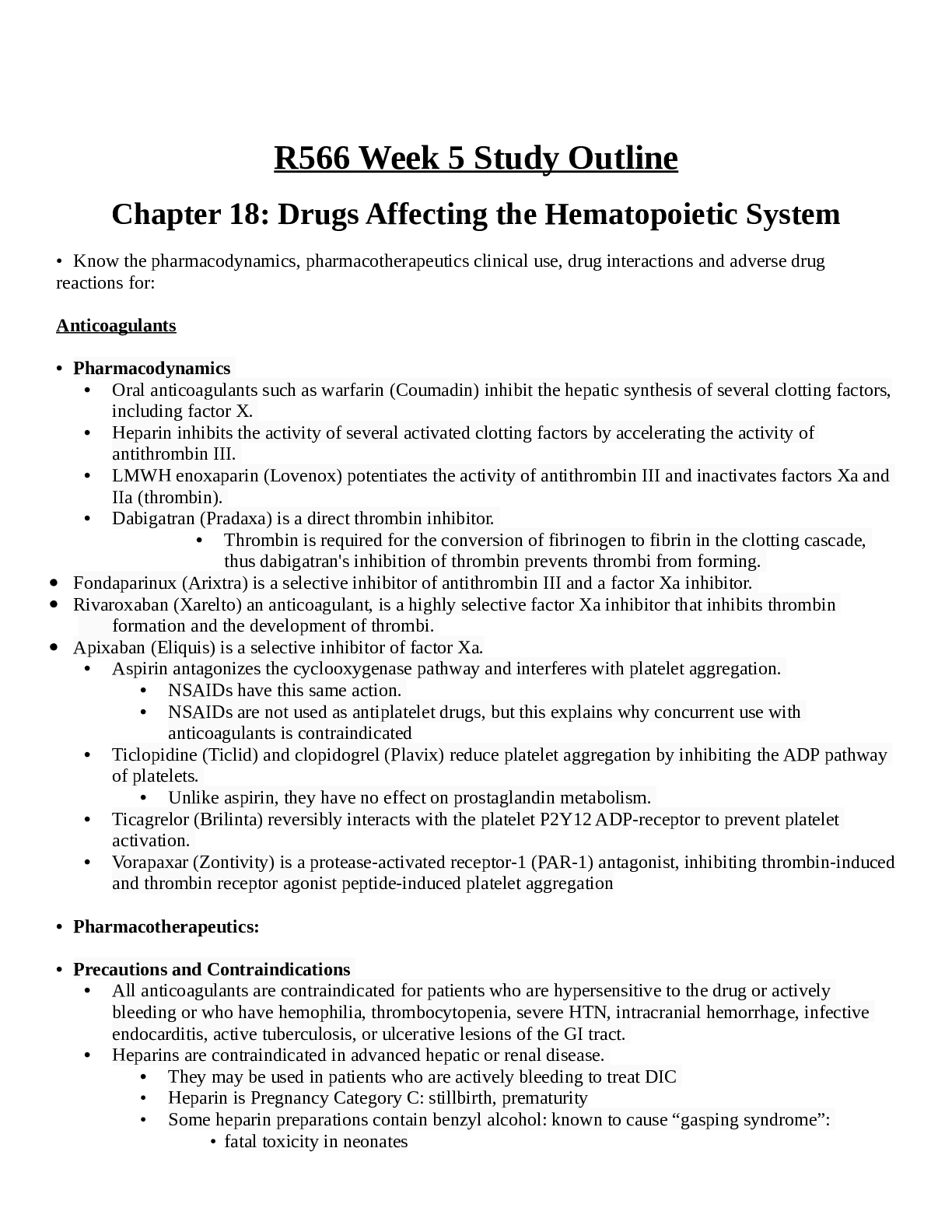
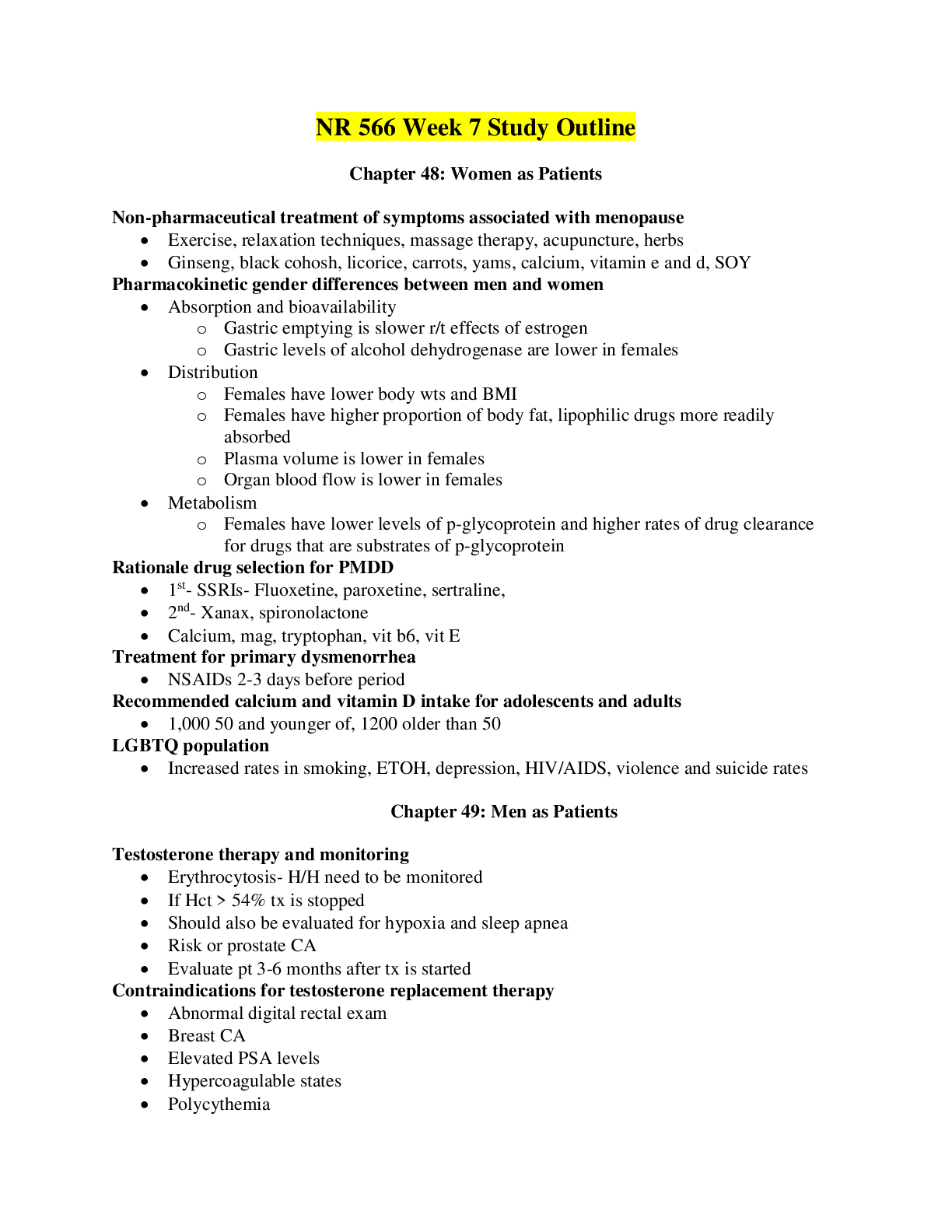


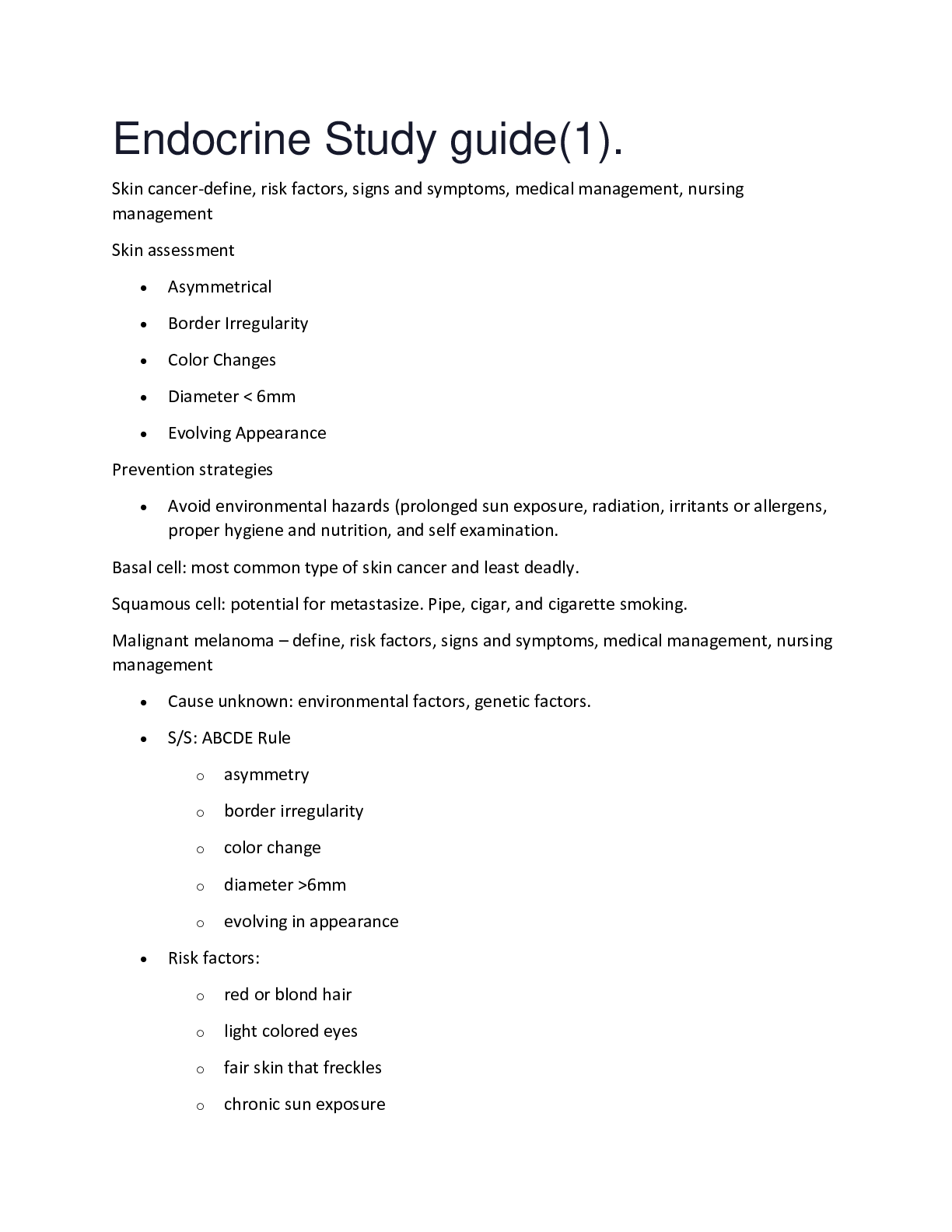
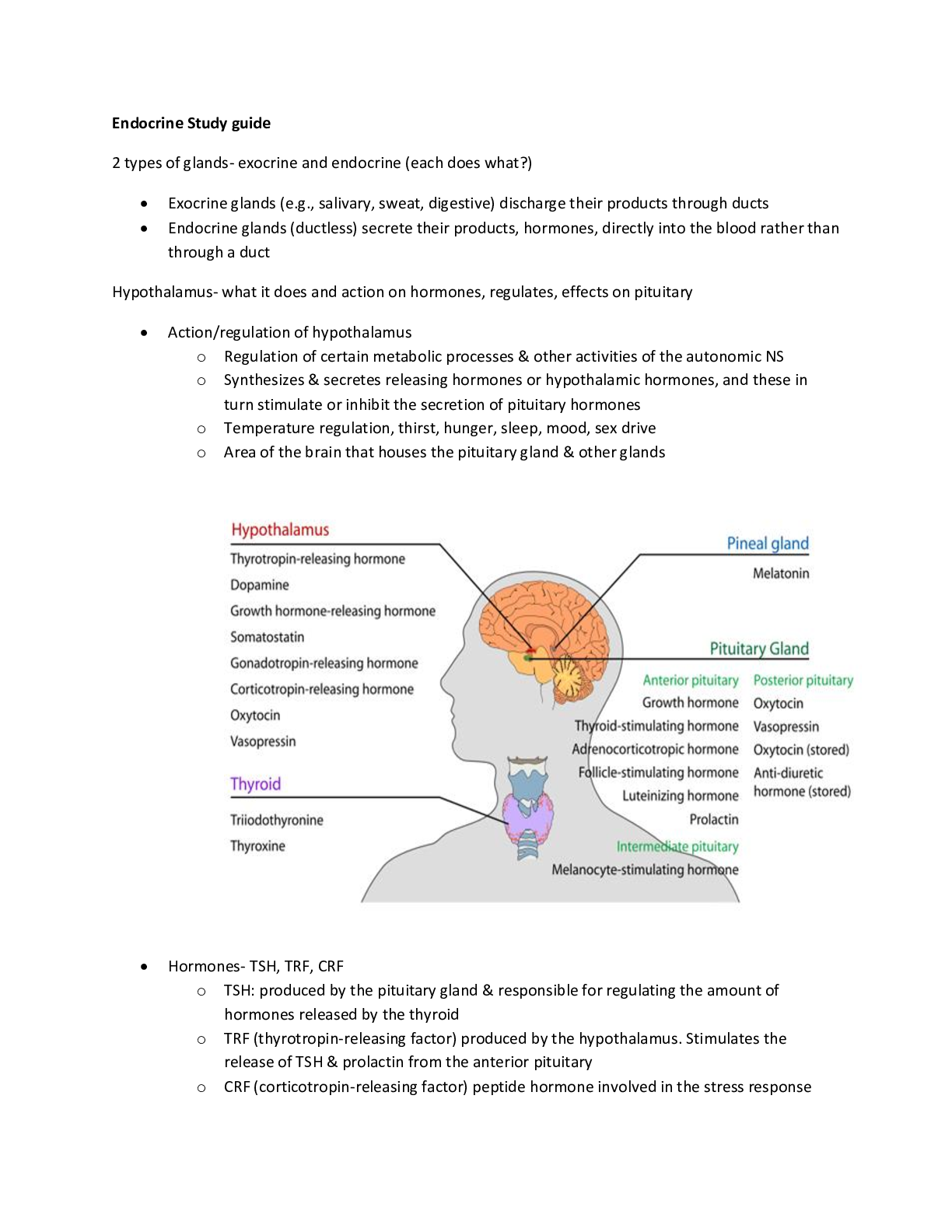

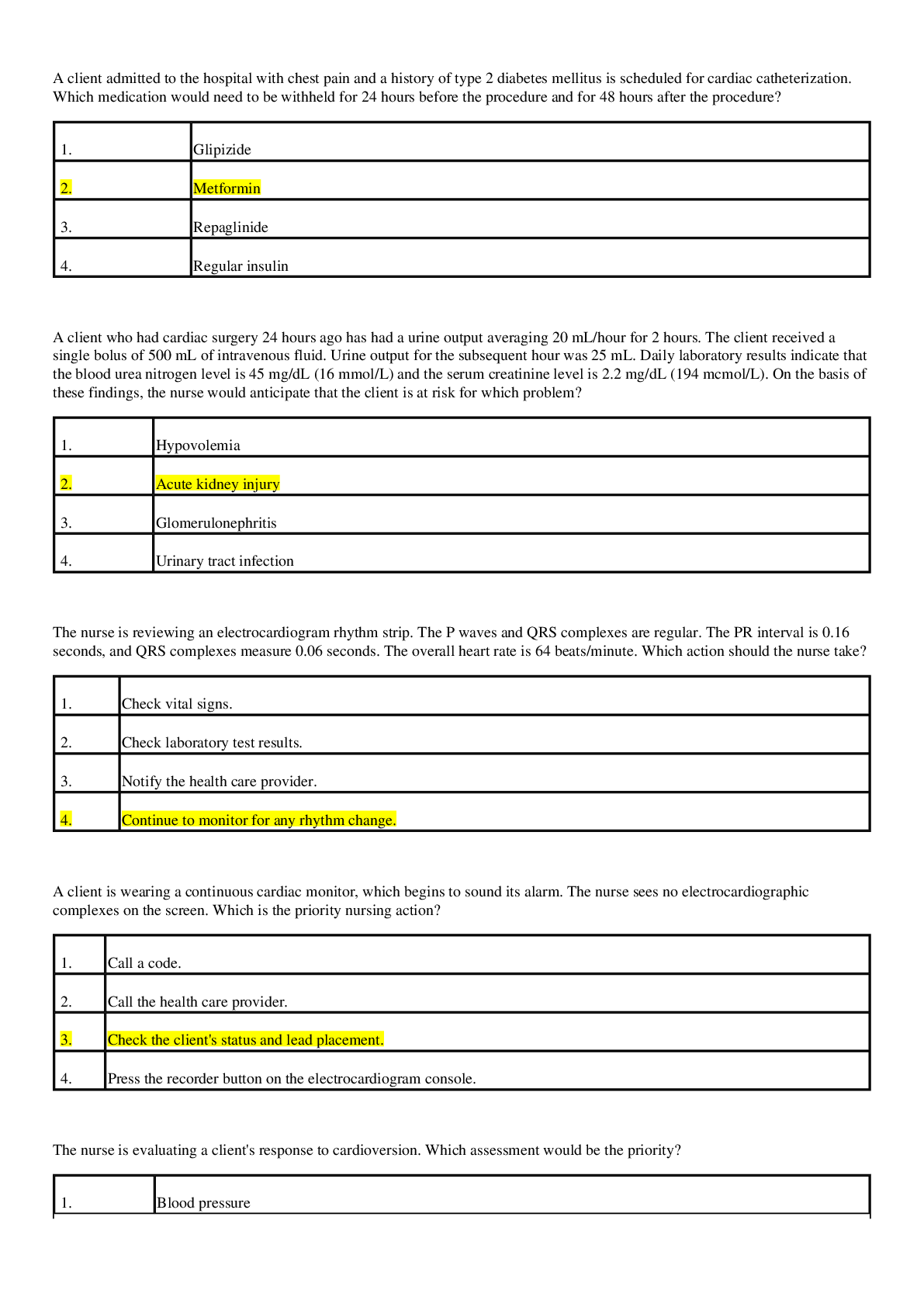
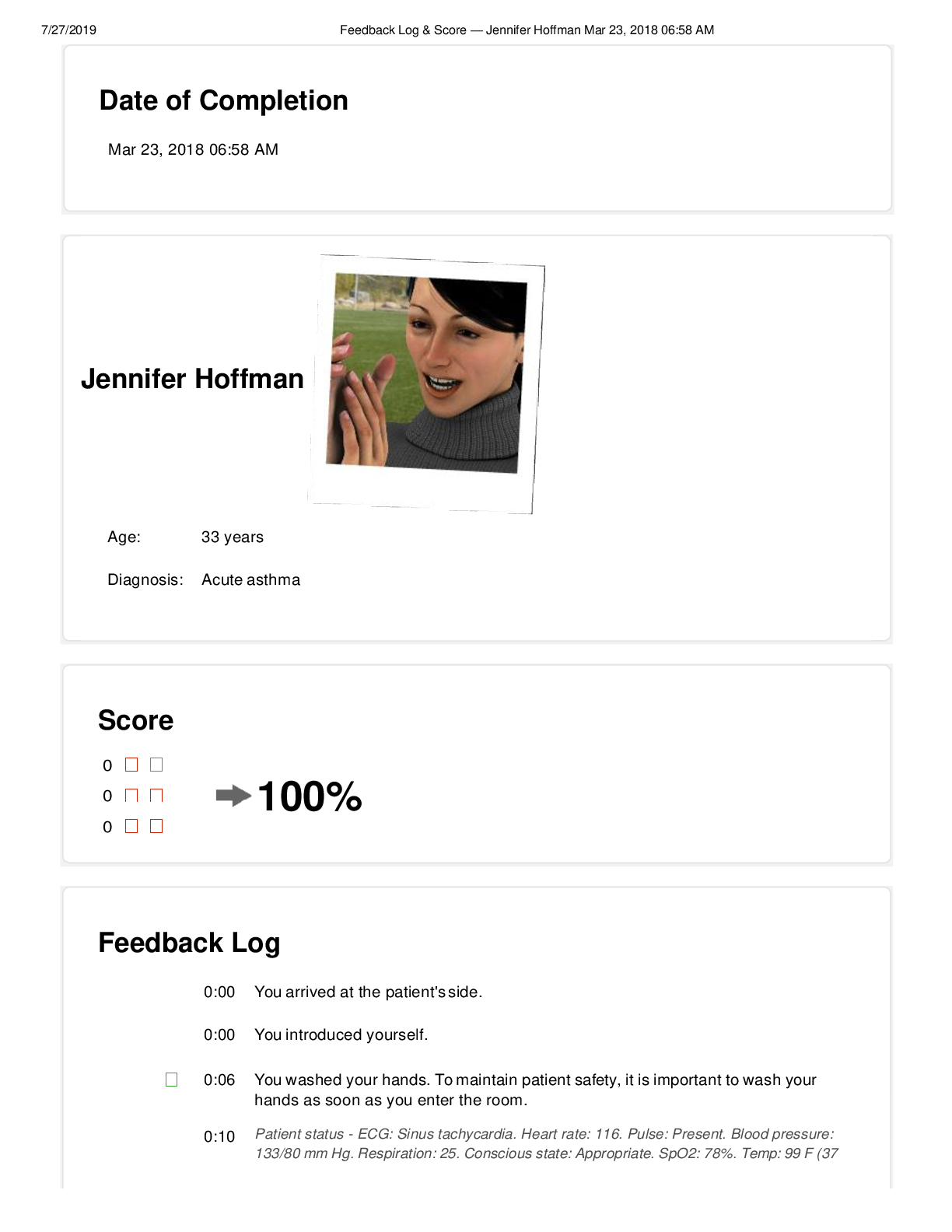

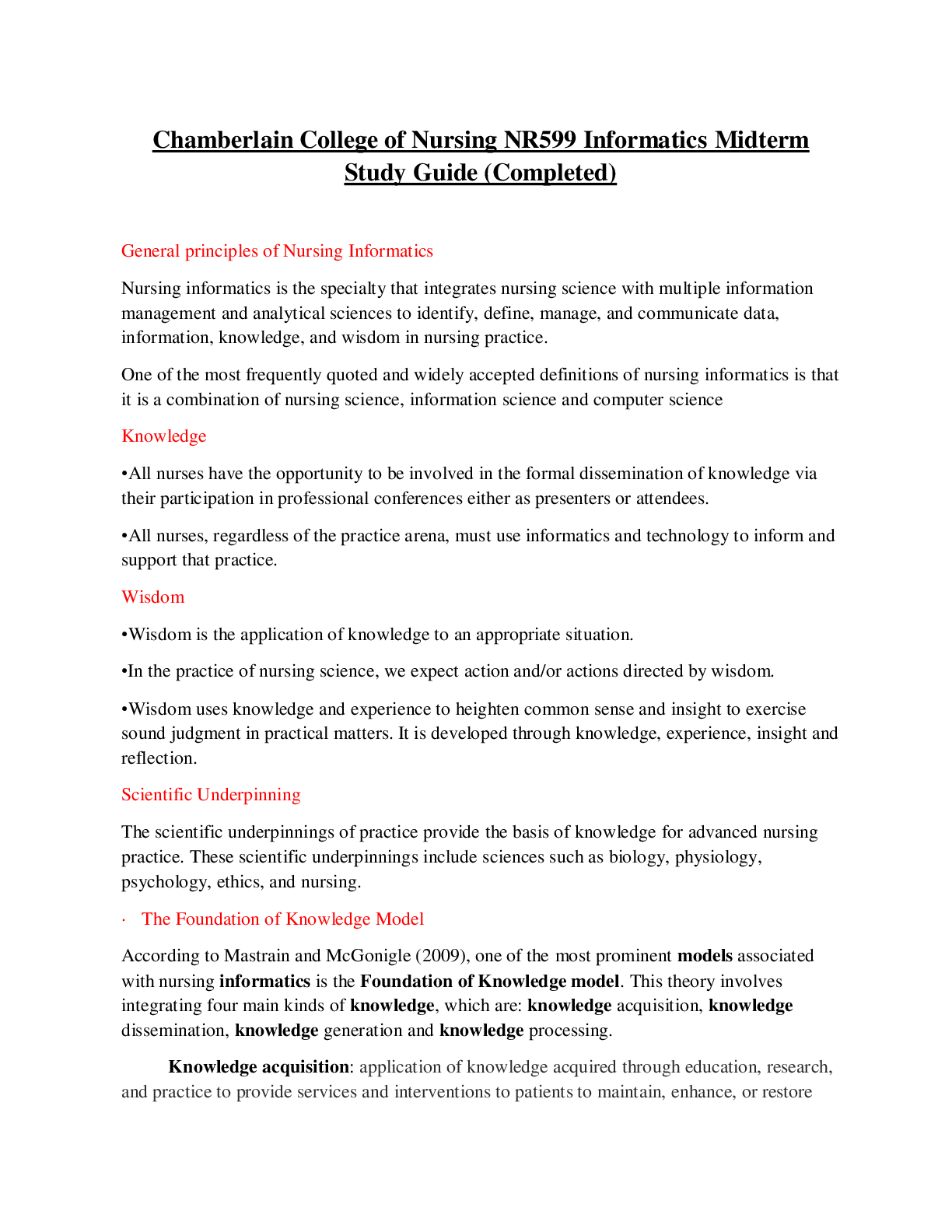
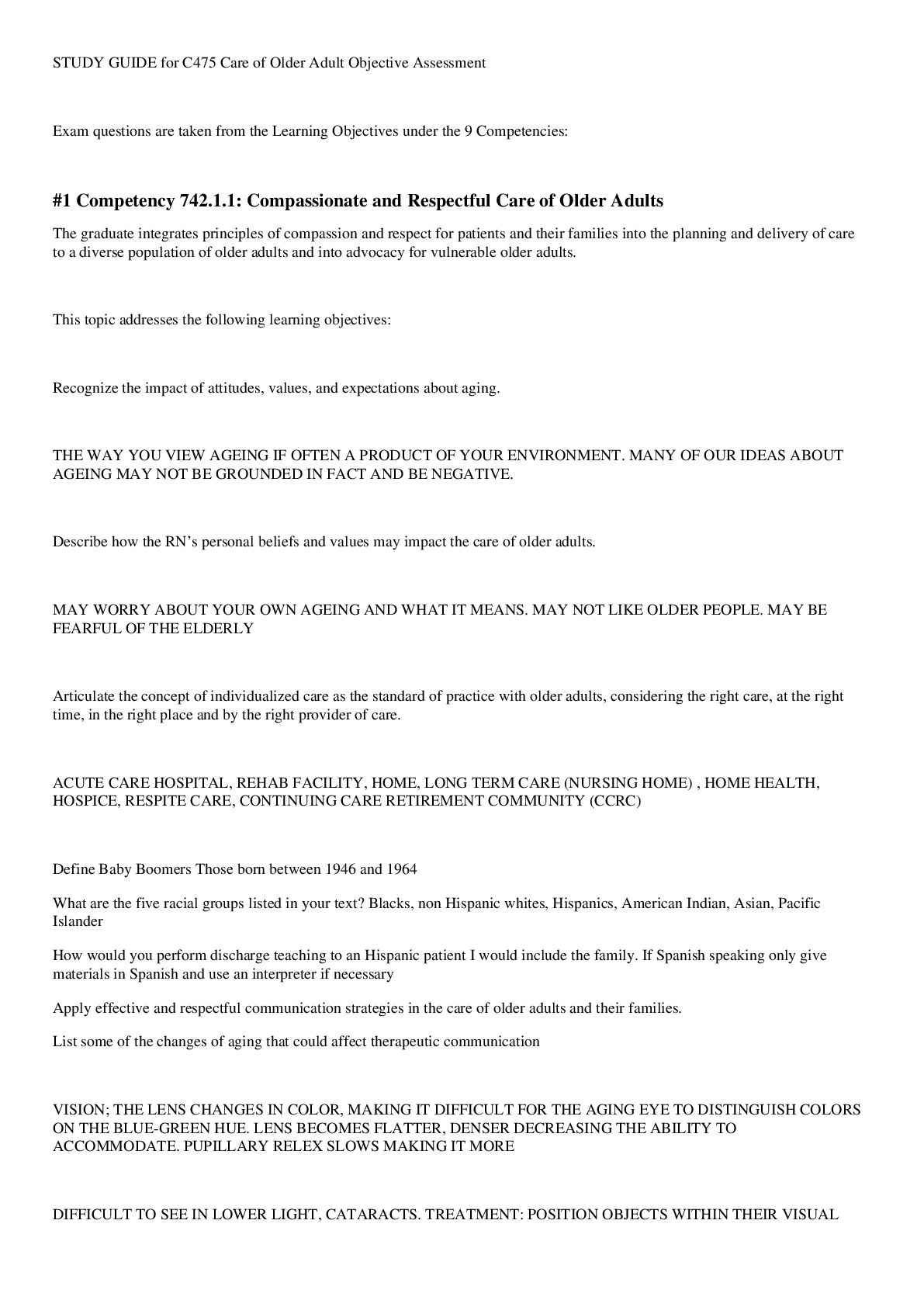

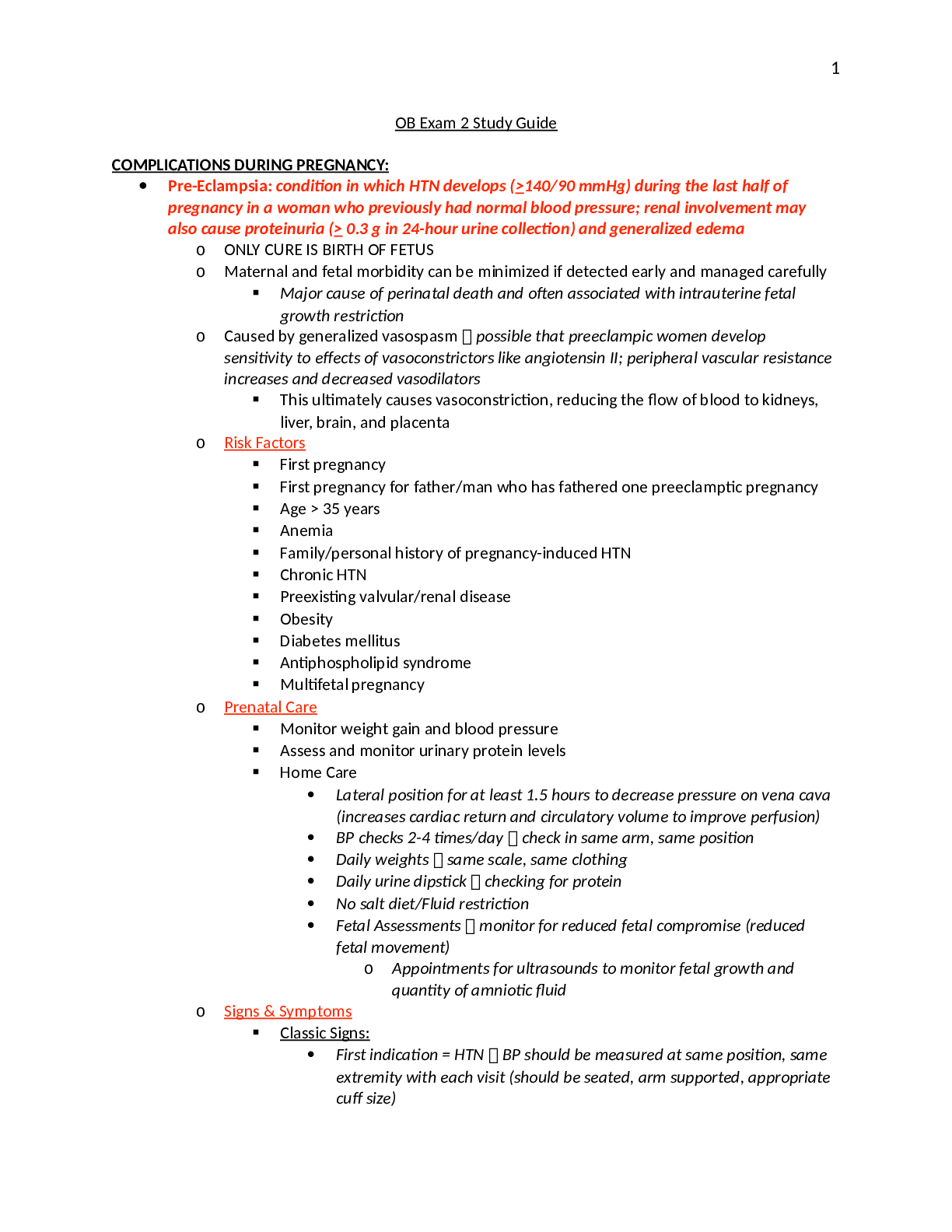
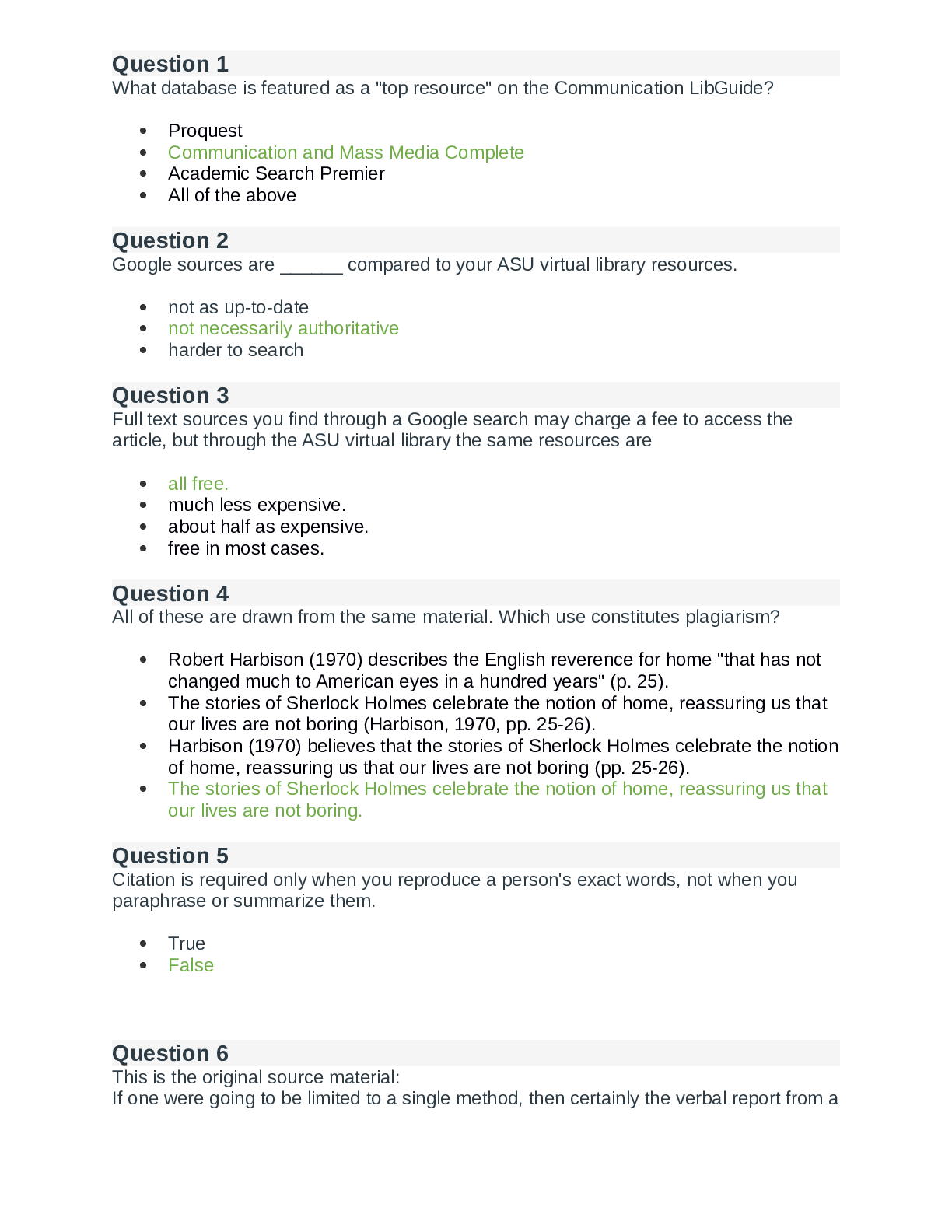
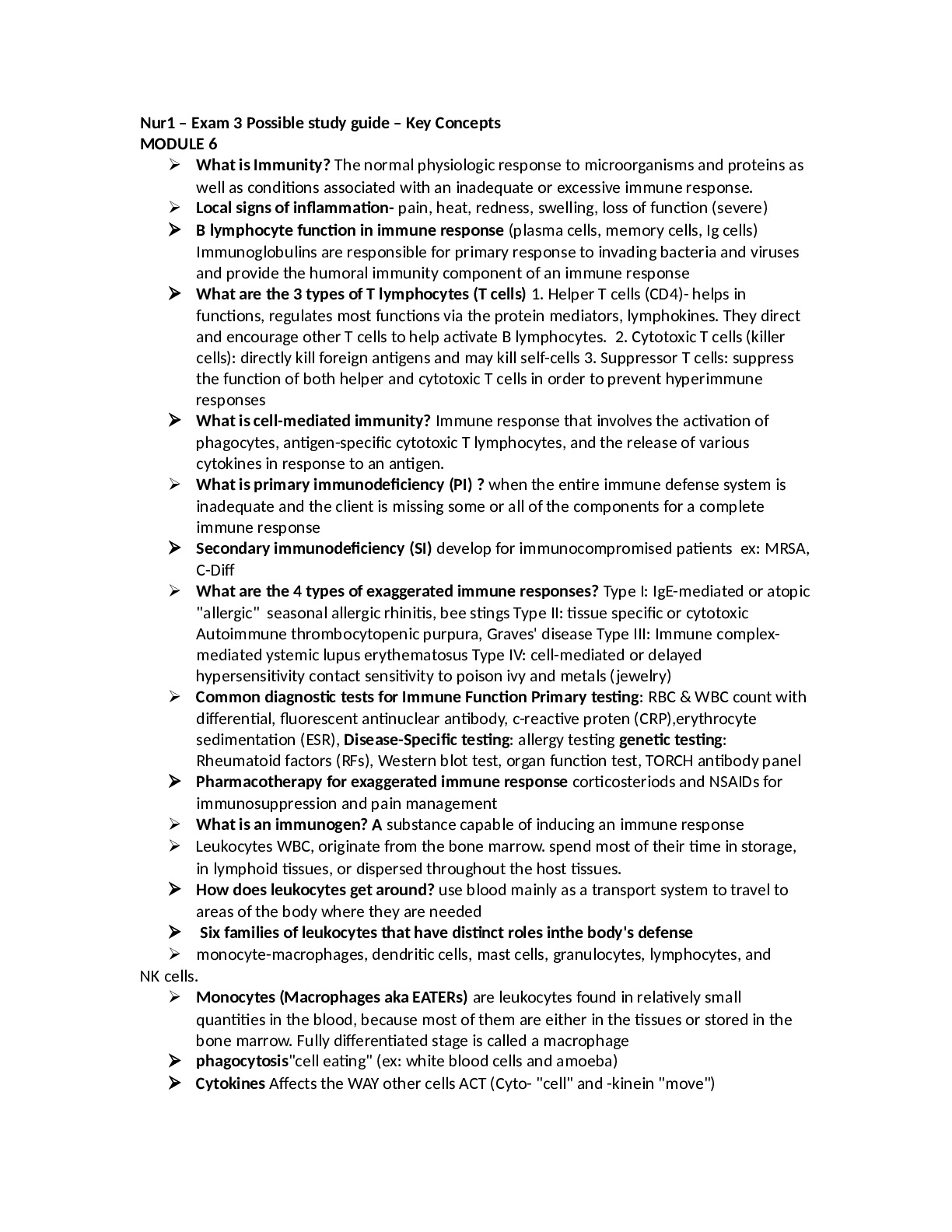

 Questions and Answers with Explanations (latest Update), All Correct, Download to Score A.png)


.png)
